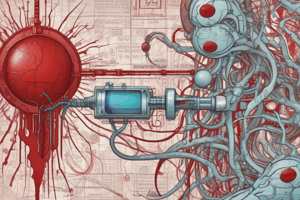Podcast
Questions and Answers
Which type of transfusion reaction is primarily characterized by severe urticarial reactions?
Which type of transfusion reaction is primarily characterized by severe urticarial reactions?
- Febrile-Non-Hemolytic reaction
- Acute intravascular hemolysis
- Transfusion associated lung injury
- Mild hypersensitivity reaction (correct)
What is a key characteristic of Febrile-Non-Hemolytic reactions?
What is a key characteristic of Febrile-Non-Hemolytic reactions?
- Involves antibodies to white cells and platelets (correct)
- Caused by acute bacterial infection
- Results in fluid overload
- Characterized by severe anaphylaxis
Which infection is known to be transmitted through blood transfusion and can lead to neurological disorders?
Which infection is known to be transmitted through blood transfusion and can lead to neurological disorders?
- Syphilis
- Chagas Disease
- Creutzfeldt-Jakob Disease (correct)
- HIV
During a mild allergic reaction to a blood transfusion, what is the immediate management step?
During a mild allergic reaction to a blood transfusion, what is the immediate management step?
Which of the following complications is classified as a life-threatening reaction to blood transfusion?
Which of the following complications is classified as a life-threatening reaction to blood transfusion?
What could potentially cause delayed hemolytic reactions in patients after receiving blood transfusions?
What could potentially cause delayed hemolytic reactions in patients after receiving blood transfusions?
What is a common sign of anaphylaxis during a blood transfusion?
What is a common sign of anaphylaxis during a blood transfusion?
Which of the following is NOT typically observed in mild transfusion allergic reactions?
Which of the following is NOT typically observed in mild transfusion allergic reactions?
Flashcards
Blood Transfusion Reactions
Blood Transfusion Reactions
Adverse responses to blood transfusions, categorized by severity, from mild allergic to life-threatening.
Mild Transfusion Reactions
Mild Transfusion Reactions
Relatively minor allergic reactions like hives or itching, easily managed with medication and stopping the transfusion.
Severe Transfusion Reactions
Severe Transfusion Reactions
Life-threatening reactions, such as acute hemolysis (destruction of blood cells) or anaphylaxis (severe allergic reaction).
Transfusion-Transmitted Infections
Transfusion-Transmitted Infections
Signup and view all the flashcards
Acute Intravascular Hemolysis
Acute Intravascular Hemolysis
Signup and view all the flashcards
Delayed Transfusion Reactions
Delayed Transfusion Reactions
Signup and view all the flashcards
Management of Mild Reactions
Management of Mild Reactions
Signup and view all the flashcards
Febrile Non-Hemolytic Reactions
Febrile Non-Hemolytic Reactions
Signup and view all the flashcards
Study Notes
Blood Transfusion Reaction
- Course Objectives: Recap last week's content, identify transfusion reactions & infections, and explain reaction management.
Recap of Blood Transfusion
- Blood products
- Blood product use and storage
- Rights of blood transfusion
- Hospital standard procedures for blood transfusion process
- Monitoring process for transfused patients
Transfusion Reactions
- Category 1 - Mild: Mild reactions, including moderate to severe hypersensitivity and urticarial reactions.
- Category 2 - Moderately Severe: Febrile-NON-Hemolytic reactions caused by antibodies to white cells, platelets, and proteins (like IgA). Possible bacterial contamination (pyrogens) is also a factor.
- Category 3 - Life Threatening: Reactions of acute intravascular hemolysis, bacteria contamination & septic shock, fluid overload, anaphylactic reactions, and transfusion-associated lung injury.
Acute Hemolytic Reactions - Symptoms
- Systemic: Chills, fever
- Vascular: Hypotension, uncontrollable bleeding
- Transfused vein: Heat sensation, pain in the lumbar region
- Heart: Increased heart rate, constricting chest pain
- Urinary: Hemoglobinuria, hyperbilirubinemia
Blood Transfusion Reaction Types
- Allergic: Mild (facial flushing, hives, rash) and severe (increased anxiety, wheezing, decreased blood pressure).
- Febrile: Headache, tachycardia, tachypnea, fever, chills, and anxiety.
- Hemolytic: Decreased blood pressure, increased respiratory rate, hemoglobinuria, chest pain, apprehension, low back pain, fever, tachycardia, and chills.
Delayed Complications of Transfusion (Other)
- Delayed hemolytic reaction
- Post-transfusion purpura
- Graft-vs-Host disease
- Iron overload
Transfusion-Transmitted Infections
- HIV
- HTLV-I & II (human T-lymphotropic virus)
- Viral hepatitis B & C
- Syphilis
- Malaria
- Chagas disease (Trypanosoma cruzi)
- Creutzfeldt-Jakob disease (a neurological disorder)
- Cytomegalovirus
- HPV
Prevention of Reactions
- Observe signs & symptoms
- Take action
- Record
- Report
Management of Mild (Allergic) Reactions
- Stop transfusion, change IV line, and maintain vein access with normal saline
- Inform physician
- Monitor vital signs
- Administer prescribed medication (antihistamine)
Anaphylactic Reaction (Life-Threatening)
- Symptoms: Signs & symptoms, respiratory distress, sudden severe bronchospasm, cardiovascular collapse
- Management: Vasopressors, bronchodilators, corticosteroids, oxygen therapy, IV fluids, antihistamines.
Management of Febrile Reactions
- Stop transfusion, change line, maintain vein access with normal saline
- Inform physician
- Monitor vital signs
- Treat symptoms (e.g., fever)
Management of Hemolytic Reactions
- Stop transfusion; change line; maintain vein with normal saline
- Inform physician
- Monitor vital signs
- Obtain blood sample from site and first urine; send to lab
- Treat shock as needed
- Send tubing, blood, to lab for testing
Management of Circulatory Overload
- Symptoms: Dyspnea, dry cough, pulmonary edema
- Management: Stop or slow transfusion, monitor vital signs, inform physician, place patient in upright position
Management of Bacterial Infection
- Symptoms: Fever, hypertension, dry flushed skin, abdominal pain
- Management: Stop transfusion immediately, maintain vein access with normal saline; obtain blood cultures, return blood bag to lab; monitor vital signs, inform physician immediately, administer antibiotics as prescribed.
Accountability (Legal Requirements)
- Record actions and observations in a timely manner, including the start and end of the transfusion.
- Report any adverse events or transfusion completion.
References cited in presentation:
- Lynn, P. (2015) Taylor's Clinical Nursing Skills 4th Ed. Wolters Kluwer
- Hogan, et al. Reviews and Rationales in Medical/Surgical Nursing
- Fundamentals of Nursing, Taylor, Lillis, Lyn & Le Mone 12th Ed
Studying That Suits You
Use AI to generate personalized quizzes and flashcards to suit your learning preferences.




